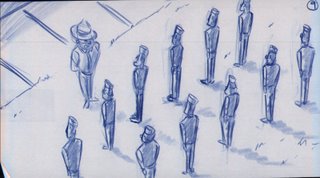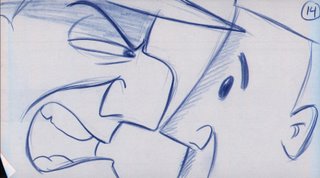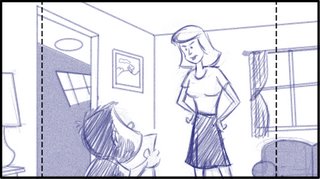
Often I find that the point of the story is being lost simply by unclear staging. To the left is an example of a scene in which a boy is showing his mom he got an F on a paper at school. The boy is giving excuses at this point in the story and fearful of his mom's reaction. Though the staging is interesting the focus has been put on the mom. This is a great opportunity for some acting on the boy but it's missed and most likely will have a long paragraph worth of dialog assigned to this single panel. Many times I will see a panel like this with both the boy's and the mom's dialog set to it. No matter if you are creating the dialog or it's coming from a script, you need to look for opportunities for acting where you can give the audience a chance to know your character.
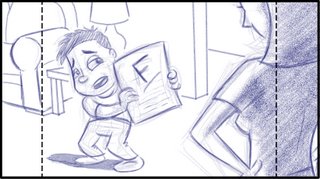
To the right is an alternate staging for the same scene. It gives the boy a chance to act and it's easy to tell right away what the scene is about. I would probably add several panels of acting in this same staging.
Now you don't always have to be so blatant as this but it works. The best would be a combination of the two shots presented here. Start with the boy and cut to the mom's reaction. Even better would be to have the boy turn away from the mom in the shot where we see the mom. This could give him some good acting where he is making outlandish excuses that we know are lies. Then the mom could call him on it.
Some board artist also tend to misinterpret things like Over-The-Shoulder (OTS) shots, thinking in means the foreground character has their back to the camera and the character in the background is facing the camera. It really just means that one character is in the foreground(possibly partially cut off by the edge of the field) and the other in the background (or other action is in the background). Try to think of alternate ways to stage a scene so it's clear. Sometimes even simple straight on flat staging will make the scene clearer and actually more interesting. Especially if you've been doing more dynamic shots one after the other.
 One of the ways you can change the mood of a scene is simply by changing the angle of the camera. In this post I have presented the same basic scene from 3 slightly different camera angles. I purposefully kept the camera on the same side of the character to help show how the change can effect the feeling of the scene. To begin with I have a level camera to the character. Here you get the feeling the lady is remembering something or someone. A scene like this often is accompanied by a camera move either in or out depending upon the point in the story that it appears. Next I have a low camera angle that give a more heroic or dramatic feeling.
One of the ways you can change the mood of a scene is simply by changing the angle of the camera. In this post I have presented the same basic scene from 3 slightly different camera angles. I purposefully kept the camera on the same side of the character to help show how the change can effect the feeling of the scene. To begin with I have a level camera to the character. Here you get the feeling the lady is remembering something or someone. A scene like this often is accompanied by a camera move either in or out depending upon the point in the story that it appears. Next I have a low camera angle that give a more heroic or dramatic feeling.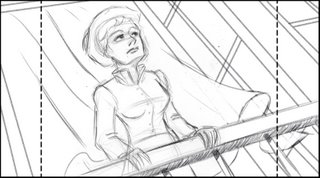 With this type of camera angle give the character a sense of accomplishment. Either that they will be able to overcome or have already have triumphed. It's basically putting the character on a pedestal. It harkens back to the age of Kings and Queens standing on their balconies looking down upon the peasants. Of course this camera angle can be pushed to the point that a character appears taller than they are. Even old propaganda posters used images of people from low angles. Accompanied with harsh shadows can make it even feel sinister. Often you will see films in which a character that is in a desperate situation use low camera angles with harsh shadows.
With this type of camera angle give the character a sense of accomplishment. Either that they will be able to overcome or have already have triumphed. It's basically putting the character on a pedestal. It harkens back to the age of Kings and Queens standing on their balconies looking down upon the peasants. Of course this camera angle can be pushed to the point that a character appears taller than they are. Even old propaganda posters used images of people from low angles. Accompanied with harsh shadows can make it even feel sinister. Often you will see films in which a character that is in a desperate situation use low camera angles with harsh shadows.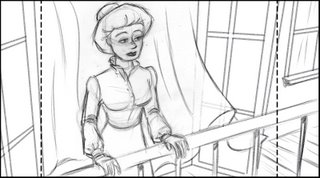 The opposite of this is the downshot or high camera angle. It gives a sense of bewilderment or loss. That perhaps the character didn't get what they were after. Like the first example you will often find a shot like this accompanied with a camera move out. It can also be pushed to give a stronger feeling. A downshot also helps to give scale and place the characters into their world. In many live action movies a crane is used to bring the camera to this angle. No matter how you use these angles it's always good to keep in mind that the angle should not feel out of place. I find it is always best for you audience to not be so aware of the camera. This included camera moves.
The opposite of this is the downshot or high camera angle. It gives a sense of bewilderment or loss. That perhaps the character didn't get what they were after. Like the first example you will often find a shot like this accompanied with a camera move out. It can also be pushed to give a stronger feeling. A downshot also helps to give scale and place the characters into their world. In many live action movies a crane is used to bring the camera to this angle. No matter how you use these angles it's always good to keep in mind that the angle should not feel out of place. I find it is always best for you audience to not be so aware of the camera. This included camera moves.





